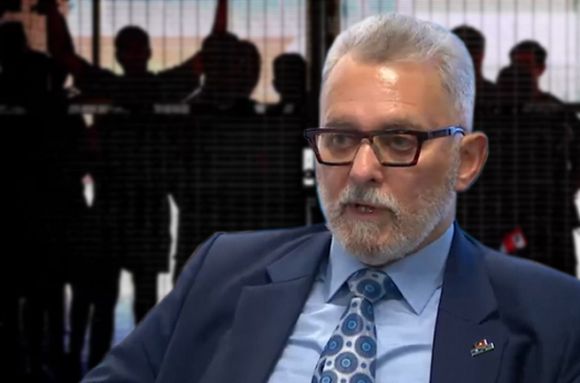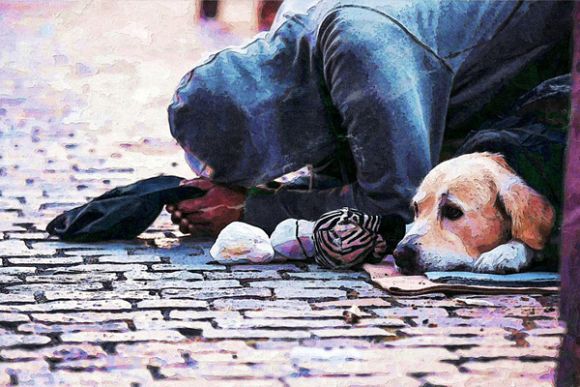Australia must do more for victims to ensure that they can heal, writes Gerry Georgatos.
*CONTENT WARNING: This article discusses suicide and sexual abuse
“Take your best shot, show me what you got. I am not afraid. I have taken so many blows I am punch drunk, one more does not matter. The day will come when I will be done.”
THERE ARE the poor and then there are the crushingly poor. Both live in the lowest quintile of income base: far below the breadline, on support payments. Their support payments are spent dry within a couple of days.
A significant proportion of the crushingly poor live on the streets. The majority are commercial precinct pavement sleepers, where there is comparatively more safety and access to amenities. Others sleep in alleyways, train stations, parks and disused condemned dwellings.
There is a youth who spent seven years on the streets. He sought the refuge of the streets to escape his abuser. Only a few per cent of reported child sexual abuse claims culminate in convictions. He ran from home because he feared either he or his abuser would soon be dead.
He was bashed several times over the seven years on the streets. He was raped. He expected to die on the streets. Because we believed in him, he began to believe. At 21, he is employed. He has secured a home. His once-homeless mother is living with him.
So many are left behind in the worst of abominations.
I am reminded of a chronic homeless woman, who is shy of four decades of life, near half her years almost continuously homeless. She has given birth twelve times. The babies were removed soon after birth, as wards of the State. Some were conceived on the streets.
She laments:
I have taken so many blows.
Hopefully my babies have gone to good homes.
I gave them life. May others give them hope.
There are the poor who I assist, who see their lot as getting through “this bullshit world”. Each day they fight to survive. While the crushingly poor see the world as wicked with no hope for those born into acute poverty. They treat each day as if it's their last.
The streets serve as some form of respite: there is an absence of some fears emanating from their family of origin. Despite being "rolled", bashed, raped on the streets, it is a blameless life on the streets unlike in the home. Only death waits and each day on the streets brings them closer to the end.
If we believe in someone, they are likely to believe in themselves. For a child to see before their very eyes the transformation of a loved one, they will love even more, hope is reborn. Anything is possible.
I remember parents who stopped displacing toxic anger on their children and heaped love, all of a sudden guiding their loved ones to their intellectuality, nurturing their inherent birthright to critical reasoning. The children started to thrive. The spread of love reciprocated by children to parents.
Love may be boundless but is not infinite. We are of fragile mortal coil and this life of ours is a small claim – there should be no hours lost to blame, anger and revenge. Forgiveness and love liberate us. We do not need to understand everything, just to live.
On the first day of this year, The West Australian newspaper published my story of what happened to me when I was nine: 'Survivor’s harrowing account shows how we must work to heal the trauma of child sexual abuse'. By no means have I absolved the perpetrator, but I forgave without the need to chase the "why".
I wrote that I was only nine years old when I was sexually assaulted by a man who, by all accounts, I should have been able to trust. The institutional setting was my primary school. The offender was a schoolteacher.
According to the Royal Commission into Institutional Responses to Child Sexual Abuse, on average, males take 33 years to finally tell someone of such abuse. In my case, it was 47 years. Three years ago, I finally told my partner and thereafter my only child. The telling was traumatic.
In 1971, I had nowhere to turn to. That is because there was nowhere to turn to — not the school itself nor the police. My young years were lived in a time in the early 1970s of impenetrable hideous silences. There was hostility to such truth, whilst also widespread disbelief of such happenings. Such was indeed the times, as indelibly portrayed by the Royal Commission.
Nearly half a century would pass without my telling any other single soul. For a little while, years ago, I engaged a psychologist. However, even then I did not divulge it. I have never forgotten the psychologist’s inquiry, one which he persevered, as to the well of my strength and resilience. He commented he could not understand, knowing more of my life than others do, from where I had drawn the endless strength and resilience he believed I have.
Life is short. Our small claim to this brief stretch of life needs to be lived unencumbered by whatever is thrown at us. We validate trauma and subsequently disable trauma and ensure the trauma does not become a lifelong management issue. The Royal Commission categorised sexual abuse towards those aged nine years and less as the worst.
I am now older than more than two-thirds of all Australians and older than four-fifths of our world’s population. The telling of these stories is important so there is much less chance than ever before of what happened to me. It should not happen to the children of today and tomorrow.
Trauma that remains unaddressed and unresolved cannot heal and where there’s no healing, trauma becomes cumulative, languishing as disordered thinking and negativity. Unaddressed child sexual abuse, in my view, is one of the worst forms of trauma which can degenerate to toxic, internalised grief.
Because of the Royal Commission, there are now fewer of these abominations.
Though I understand the schoolteacher who perpetrated vile on me was a multiple predator, I have forgiven him. I do not hate him. Everyone is accountable foremost to oneself. No one can escape oneself. I have never sought to chase him down, though ironically, I have chased others down to the point of incarceration because they were present threats to the safety, wellbeing and very life of others.
Perpetrators can step up and come forward, admit and own their vilest sins and journey to their own mortal salvation.
We must do everything we can to reduce abominations but we must reason, we must grieve, we soak in grief but do not blame ourselves nor futilely lose ourselves in revenge and subsequently drown in "endless" grief.
Suicide is the loneliest experience. A fading light. It takes a whole lot of courage to end life.
According to the Australian Bureau of Statistics (ABS), Australia’s highest suicide rates, 17.8 to 18.4 suicides per 100,000 population were in 1913, 1915, 1930 and 1963. Years immersed in social and economic upheavals, cumulative socioeconomic stressors and high unemployment levels.
The 1970s and 1980s experienced decreasing suicide rates and this coincided with the introduction of universal healthcare – Medibank and Medicare – and free tertiary education (abolished in 1989). Suicide mortality decreased during those two decades.
Social housing builds were at their highest rates – but during the last three decades, the rate of social housing builds dramatically decreased. Of course, there are outlier years where the suicide rate escalates or reduces against the trend. Correlations are realised: it’s a year of real wages increased to cope with cost-of-living pressures, investments in social care systems and funding that "hits the ground".
Why can’t it always be this way?
To quote the Australian Institute of Health and Welfare (AIHW):
“While the reasons for an individual’s suicide death are personal and often complex, overall peaks and troughs in rates and numbers of deaths by suicide historically coincide – more or less – with social and economic events.”
We must implore the facts in narratives on ways forward. The street homeless are violated by hideous reprehensions on a near-daily basis. We must vest every support foremost to our most vulnerable. In so doing we build a firmament which dramatically reduces the suicide toll, the carceral toll, reduces cumulative combustive trauma.
We cannot have royal commissions without proportional investments. We know of the burden of diseases, well there is now the burden of trauma. We have flooded humanity with trauma discourses, but we do not invest in the healing and positive ways forward. With the suicide crisis, as a nation we are leaders in suicide awareness but laggards in suicide prevention.
If we house the homeless, if we restore the lives of the incarcerated and invest in those affected by abominations, we will begin to go some way forward. We must always remind ourselves the greatest inroads will be made with those poorest, where the greatest volume of tragedies lay.
To quote the AIHW:
'The peak in overall suicide rates in 1930 was driven by an increase in male suicide rates, peaking at 29.8 deaths per 100,000 in 1930 — the highest rate ever recorded. Similarly, the increase in overall suicide rates in the 1990s was also mainly driven by an increase in male rates. The peak in the 1960s reflects a rise in suicide rates for both males and females.'
1930 was the toughest year of the cataclysmic Great Depression. 1963 was hit by a fisty economic recession with families enmeshed by unemployment and charity was all there was. The 1990s delivered disastrous economic recessions, house prices went through the roof and social care systems were eroded or made unaffordable for those living below the poverty line.
For many proximal to the poverty line, life became one of the mounting sacrifices.
Although males are more likely to die by suicide, females are hospitalised for intentional self-harm twice as frequently as males.
According to the ABS, the highest proportion of deaths by suicide occur during mid-life. More than half of all deaths by suicide in 2020 occurred in people aged 30-59 (1,637 deaths) compared with 24 per cent for those aged 15-29. The life expectancy for street-present homeless persons appears what most consider mid-life.
If you would like to speak to someone about suicide you can call Lifeline on 13 11 14.
Gerry Georgatos, the son of CALD migrants, is a suicide prevention and poverty researcher with an experiential focus. He has a Master in Human Rights Education and a Master in Social Justice Advocacy & Civil Rights Arbitration. He is the national coordinator of the National Suicide Prevention & Trauma Recovery Project (NSPTRP). You can follow Gerry on Twitter @GerryGeorgatos.
Related Articles
- Homelessness crisis turning Australia into 'Nomadland'
- Australia's governments must be held accountable for the homelessness crisis
- WA Government has betrayed its homeless
- It's time for governments to put the homeless first
- Australia must build 150,000 public rental homes and end all forms of homelessness
 This work is licensed under a Creative Commons Attribution-NonCommercial-NoDerivs 3.0 Australia License
This work is licensed under a Creative Commons Attribution-NonCommercial-NoDerivs 3.0 Australia License
Support independent journalism Subscribe to IA.
















